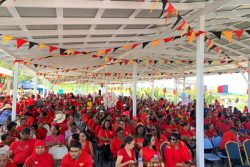There is a justifiable case for the Guyana Press Association (GPA) not being entirely satisfied with the apology tendered by Minister Khemraj Ramjattan arising out of his recent encounters with media operatives. This includes, we are told, his use of decidedly indelicate language during a brief but acrimonious exchange with one particular journalist in the presence of others at last week’s farewell parade for outgoing Commissioner of Police Seelall Persaud.
On the one hand, it has to be said that Minister Ramjattan’s ‘apology’ is not the sort of exercise in contriteness which our high officials customarily demonstrate in the face of what, sometimes, is their coarse and dismissive treatment of probing journalists. On the contrary, that sort of behaviour is, all too often, attended by an absence of even the remotest gesture of belated regret. It is as though the media’s place in the accepted pecking order disentitles it to such consideration. On the other hand, it has to be said that the Minister’s apology, appears, at times, to have been less than generously tendered. That is, perhaps, why one suspects the GPA has expressed a lack of complete satisfaction with his offering. Still, there is every chance that he may have set a precedent.
This is the second time in a few weeks that the GPA has sounded its collective voice in protest over what it believed to be unacceptable treatment at the hands of officialdom, the first occasion earlier in the year being the shabby treatment of a media group that had gone to Ayanganna to cover an official assignment. One might add that in the instance of Ayanganna, no apology or any other comment has been forthcoming from the army, notwithstanding what we understand to have been a directive from the President that the GPA’s protest be investigated.
The real value in having occurrences of this kind publicly ventilated is that the ensuing discourse provides opportunity for a broader and, frankly, much needed examination of the relationship between the media and officialdom, which one hopes the Guyana Press Association will continue to pursue with the requisite vigour and intellectual acumen. This is necessary if that all-important two-way flow of communication between officialdom and its various publics is to be realized. That is why, twice in recent weeks, we have proffered an editorial comment on the aforementioned Ayanganna issue and why we have chosen as well to discuss the nexus between Minister Ramjattan’s apology and the broader relationship between the media and officialdom.
In those earlier editorial comments on the matter involving the GDF we sought to make the point that these instances of what, unquestionably, are indicators of a less than merited regard for the media and its work (here, it is important to point out that this tendency is not universal among public officials and institutions) derives often from what is a flawed interpretation of the role of the media and a feeling that the manner in which official information is publicly disseminated can and should be directed from above. Put differently, official behaviour frequently amounts to cynical attempts to call the shots with regard to what is disseminated and how that dissemination takes place, a circumstance that derives from the historic availability of a state media infrastructure that still exists at the beck and call of the government of the day. As such, it is always ready and willing to fix the dissemination of information to suit its image-enhancing requirements.
The other consideration that applies to some of our serving high officials is that not having been as thoroughly oriented as they ought to be in the proper practices associated with engaging the media, they have adopted postures of suspicion and defensiveness towards independent media houses, driven by an instinctive suspicion that those media houses are up to no good. Such a posture not only amounts to an unacceptable abdication of an important responsibility of public office but, as in the case in some of the relationships between state officials and private media houses, makes for enduringly contentious, even openly hostile relationships.
Sometimes too, official reluctance to engage the independent media appears to be little more than a thinly veiled disregard for the free and unhindered flow of information, declarations regarding the virtues of a free press notwithstanding.
Going forward, there is the likelihood that there could be an increase in the instances of these kinds of issues arising between the independent media and officialdom, the reason being that the dynamic of government/media relations in Guyana is unravelling and being re-set at a pace with which officialdom, all too frequently, appears to be decidedly uncomfortable. One of the manifestations of this shift has been a radical departure on the part of the independent media from the historic grin-and-bear-it posture which they had hitherto adopted in response to official discomfort with reporting that challenged official versions of events. These days, there is a far greater degree of media probing, a measure designed to render officialdom more accountable; and whereas the earlier environment had afforded state officials a comfort zone where probing media could not easily reach them, that safe space has been steadily eroded by an incremental national, regional and global clamour for greater media freedom which we in Guyana have gradually enjoined.
There have been cases in which the challenge of responding to the changing ground rules associated with greater media freedom in Guyana has been a discomfitting experience for our politicians. Remedying that can only come through official acceptance of the paradigm shift in media-state relations. Changing that dynamic can only come through coming to terms with the fact that times have changed and that we are compelled to change with them.
The protestations of the GPA in relation to the incidents involving the GDF and Minister Ramjattan would seem to point to an enhanced preparedness on the part of the collective media corps (membership of which, interestingly, includes state media functionaries) to take up the challenge of securing a greater measure of official respect for the media and recognition of its free-press responsibilities.
It is a good thing for Minister Ramjattan to have backed away from what, by his own admission, were his intemperate and altogether inappropriate outbursts. That those occurred in the first place, points to the fact that we still have a fair way to go in pursuit of a media culture that is underpinned by tolerance and openness. At least, however, we are beginning to witness clear signs of change.









